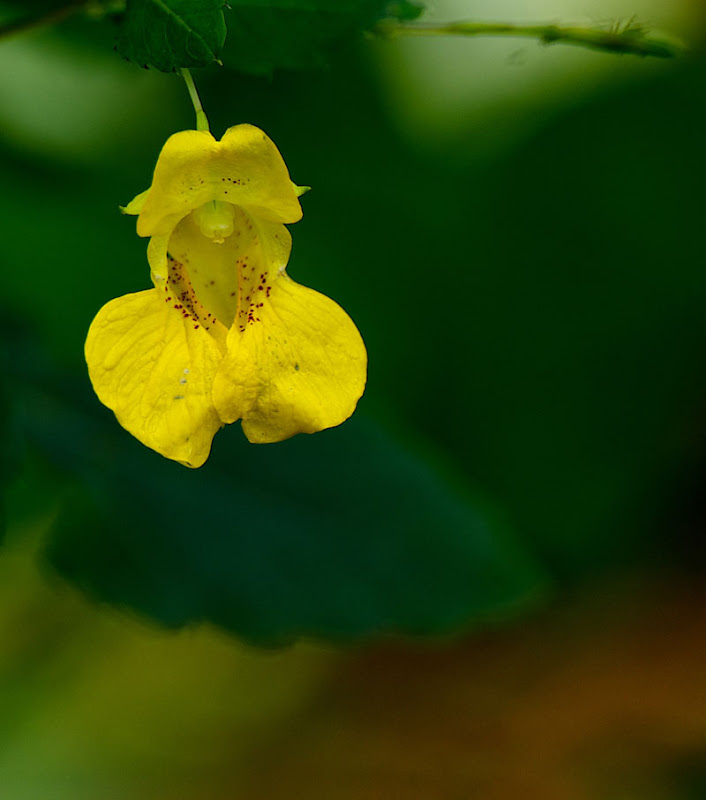Nodding in the damp edges along the Little Miami River, this beautiful yellow jewelweed flower dangled from its stem like a perfectly crafted pendant...
I always assumed this flower was named Jewelweed because of the brightly colored yellow and orange jewel tones of the flowers, but it's not. I just read in my "Wildflowers of Ohio Field Guide," by Stan Tekiela, that it's named after the leaves. When water droplets form on the leaves, they shine like tiny, silvery jewels, and according to "Wildflowers of Ohio," by Robert Henn, when the leaves are placed under water, they shine like silver! I tested it out, and it's true.
This summer while looking for turtles with Paul along the Great Miami River I went off trail a lot and went through several patches of stinging nettle. Ouch...those teeny weeny urticating hairs go through anything, including jeans! The stings burn intensely for about 15 minutes, but then fade, so it's not too bad. The hairs on stinging nettle work like the urticating hairs on stinging caterpillars like the American Dagger Moth Caterpillar (click here for a post) and the Buck Moth Caterpillar (click here for a post). Basically, the hairs are like tiny needles that break off in the skin and dump in several chemicals: acetylcholine, histamine, 5-HT or serotonin, and formic acid (source: Wikipedia). The result is a burning sensation or sting that lasts about 15 minutes. On some, the sting can last much longer, even a day or so!














18 comments:
I'll keep an eye out for the yellow kind in my wanderings today; I've already gotten plenty of shots of the orange kind. I hadn't realized they were members of the Impatiens family. Cool!
These are beautiful pictures!
I have never seen this flower, it looks like an orchid. The re-seed like the impatiens do.
Thank you for the information on this flower and your upcoming experiment, YOU are BRAVE! Will be interesting to see what your findings are.
Wow what a beautiful one and that first shot is amazing Kelly. I love the contrast between the green background and the yellow of the flower. Beautiful post!
great post
Thank you so much
- KAT -
It's amazing that such a large plant is annual and starts over from seed each year! They're practically shrub-sized. Jewelweed was actually the source of an early natural history epiphany for me... I was by the ditch in the back of my childhood backyard, looking at the "poppers" (none of the kids in my neighborhood knew the proper name for the plants, but we called them that because of the spectacular popping seed pods, which provided hours of entertainment). I watched the bumblebees climbing in and out of the flowers, realized that the flowers were the EXACT right shape to hold the bees, and voila, I'd discovered coevolution.
i hate nettles!
your first photo - looks like a girl sitting down, hands crossed in front of her, head hanging low, while her skirt flows around her legs. :)
Lovely photos, Kelly...I've only seen the orange type here.
The thought of you actually brushing up against stinging nettle 'on purpose' made me smile, Kelly. I've only encountered contact with it once, across my ankle and lower leg...hope to never again! You are brave!
Hi Kelly,
Some stunning photos of a beautiful flower, a plant I don`t remember seeing before!
J
Follow me at HEDGELAND TALES
Such a beautiful color! Very nice captures, Kelly.
Beautiful, beautiful photos!
Beautiful photos Kelly, a greeting from my madness.
Very informative. I have felt the results of Nettle but I don't know what it looks like. I look forward to seeing this in the future.
Hte Jewelweed reminds me of a tiny orchard. So pretty! I also didn't know they were part of the impatiens family.
There's something about it that reminds me of orchids. I've seen the orange one but never this color before. Thanks.
Wonderful post! I've not seen the yellow jewelweed. I remember stinging nettles as a child. They 'got me' several times. I'd have the jewelweed in hand prior to your test :)
...thanks, everyone! I mostly see the orange flowers too, but along this spot yellow is king! It really does look like an orchid...and a lady's slipper.
Hi Kelly
I loved the way you managed the framed the shots of the Jewelweed they are quite lovely. We had Stinging Nettles at the cabin this summer I will, carefully keep my eyes open next year.
Regards
Guy
...yikes, Guy! It sounds like you might have become acquainted with the lovely sensation of stinging nettle! :-) Yes...I'm careful when I see it now too.
That's interesting, Kelly. Here in California impatiens is a common colorful garden plant, but I've never heard anything like that about the seeds. And they don't have the long tubular shape.
Post a Comment